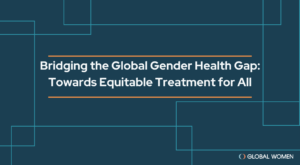
Across the globe, women spend 25% more of their lives in debilitating health than men, the World Economic Forum reports.
Longstanding gender biases continue to impact the quality of healthcare women receive. Recent research finds that women in emergency rooms experience longer waiting times, are less likely to be assessed for pain, and are less likely to be given pain medication. In Denmark, women are diagnosed with health conditions on average four years later than men, despite being more likely to see medical professionals early on.
While heart disease remains the number one cause of death globally, past research has shown that women are 50% more likely to be incorrectly diagnosed following a heart attack. Data shows that, across Europe, women are both more likely to die following a heart attack, and less likely to be prescribed medication to prevent future heart attacks.
Conditions that disproportionately or exclusively impact women or people assigned female at birth show evidence of further disparities, with endometriosis nicknamed ‘the silent disease’ due to rampant underdiagnosis. Across the world, 10% of people assigned female at birth are affected by the debilitating chronic disease. However, in the USA only two out of every ten endometriosis cases are diagnosed. Diagnosis itself takes more than seven years, with the time frame even longer for African American women. Women with endometriosis routinely report that their experiences are dismissed or minimised while seeking medical support.
Antimicrobial resistance is a growing cause of death globally, and new research suggests that women are more likely to be exposed parasites, bacteria and viruses that are drug resistant. In areas with lack of adequate sanitation and sterile conditions, women are more likely to be exposed to superbugs during childbirth or when undertaking household chores. The knock-on effect of gendered occupations, such as healthcare, and the gender health gap itself leading to women being more likely to take antibiotics are further reasons for women being disproportionately impacted.
Autoimmune diseases such as lupus, psoriasis, multiple sclerosis, thyroid diseases and rheumatoid arthritis, are more likely to impact women, and are the third most prevalent disease category worldwide. Women comprise 80% of the people impacted by autoimmune diseases, with recent evidence suggesting a biological predisposition. As with other conditions that disproportionately impact women, autoimmune diseases have historically been understudied, with limited treatment options available.
The tendency for medical research to focus on men has likewise resulted in neurodivergent women and girls being underserved and underdiagnosed. With symptoms presenting differently for girls and women, autism is diagnosed in three times as many boys than girls. As a result, autistic women often miss out on vital treatment, support and accommodations. Both autism and ADHD are more likely to be diagnosed later in life, leading to neurodivergent women suffering mental health problems in adulthood. In the USA, less than 1% of women are diagnosed with ADHD. However, research suggests the number is growing and the gap is narrowing. In 2022, men were 28% more likely to be diagnosed with ADHD, as compared to 133% more likely in 2010.
To address the healthcare disparities women face globally, a coordinated response is necessary. This includes more inclusive research, better education for healthcare professionals on gender differences, and improved diagnostic approaches. Steps must be taken by all stakeholders in the health sector to ensure equitable health services and outcomes for all genders.
Read more about these ‘Six Conditions that Highlight the Women’s Health Gap’ here.
